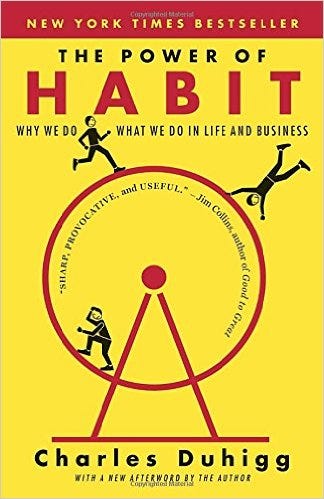This book takes us to the thrilling edge of scientific discoveries that explain why habits exist and how they can be changed.

Habits are “auto-pilot” routines that save effort (energy)
Do you ever have to consciously think how to ride a bike or brush your teeth? No? That’s because you built a habit out of those activities.
Our brains constantly look for ways to save energy. One way to do this is to turn activities into habits. Complicated acts which demand concentration at first, become effortless habits eventually.
Research shows that about 40% of our daily activities are based on habits instead of conscious decisions.
The three general parts of habits
- An external cue, for example, your alarm clock, creates an overall spike in your brain activity as your brain decides which habit is appropriate for the situation.
- Once the best routine (if available) is decided, the brain switches to “autopilot mode” until you finished your routine, for example brushing your teeth.
- Finally, comes the reward. Your brain activity increases once more as it registers the completion of the routine and you get the reward of feeling good. In this case a minty-fresh sensation in your mouth. Also, the link between the cue and the routine gets reinforced.
Learning and maintaining habits happen in the part of the brain called basal ganglia, a part of the brain which even works if the rest of the brain is damaged. That’s why habits are incredibly resilient.
Habits stick because they create craving
Animal studies have shown that once they become used to a cue-routine-reward habit, their brains begin anticipating the reward even before they get it. Denying them the reward once they anticipated it makes them frustrated and mopey. Sounds familiar? That’s how most of us react when we try to get rid of bad habits, like consuming a lot of sugar.
Fortunately, cravings work for good habits as well. Research shows that people who exercise habitually crave something from the exercises, it could be the endorphin rush, the sense of accomplishment or a plethora of other things.
Companies and advertisers understand and utilize cravings from habits. One example is the rewarding tingling sensation that toothpaste create.
Change habits by substituting the routines
As smokers trying to quit will probably know, it’s hard to ignore cravings for nicotine. The trick is to still respond to the cue (craving) but with another routine (something other than smoking).
The golden rule of changing habits is keeping the same cues and rewards, but changing the routine.
Alcoholics Anonymous (AA) and other big habit changing organizations use this principle with great success.
They ask the participants to make a list of the cravings they have from drinking. Often it is not drinking itself but other factors like relaxation, socializations, and companionship what they want. AA then provides new and less harmful routines to replace the old intoxication routine.
In general, this principle works well but relapses happen, in particular, a stressful situation can trigger a relapse. For example, if a recovering alcoholic gets the news that his mother has cancer.
Belief is the differentiating component between relapses and sticking to the new routines
Research found that belief is a crucial factor in overcoming bad habits. Spirituality and God feature prominently in AA philosophy, but it is not the religious factor itself that helps people.
They need to believe that change is possible for themselves, and spirituality or religion can provide it to them.
Changing a keystone habit can trigger other positive habits as well
Some habits are more important than others. Those are the so-called keystone habits. Adhering to them can create positive effects in other areas as well.
The reason Keystone habits work is that they provide easily attainable success in a small area. That success causes belief that change is possible in other areas as well, causing a cascade of positive changes.
Willpower — the most important keystone habit
Research suggested that willpower is a keystone habit which can be applied to other areas of life and that it is in fact, a skill which can be learned.
Willpower is also like a muscle, we can only use so much willpower before it gets exhausted. That explains why willpower can be so inconsistent, some days we just don’t want to leave the sofa.
Fortunately, the muscle analogy also shows how we can train our willpower in order to strengthen it. By doing that our willpower muscle gets more endurance so to say.
Mental preparation for certain situations can also help make willpower more enduring.
Other studies show that lack of autonomy affects willpower adversely. People who do something by choice have more willpower endurance than if they follow orders.
Check the summary of the book Willpower to learn more about Willpower
Companies take advantage of habits
Retailers use data analysis to track customers. They have become so good at it that they can often tell if a girl is pregnant even before her family knows it.
In order to prevent people getting upset about being spied on, they learned to target them in a less obvious way. Instead of directly sending baby coupons to the address of the customer, they buried it among unrelated offers, giving the impression that it is just another untargeted ad.
DJs can take advantage of habits by embedding a new song between two popular songs, raising the likelihood that the new song will become popular too.
How to fix bad habits
Once we become conscious of a bad habit, it is our responsibility to change it. So the first step is acknowledging that we have a bad habit.
